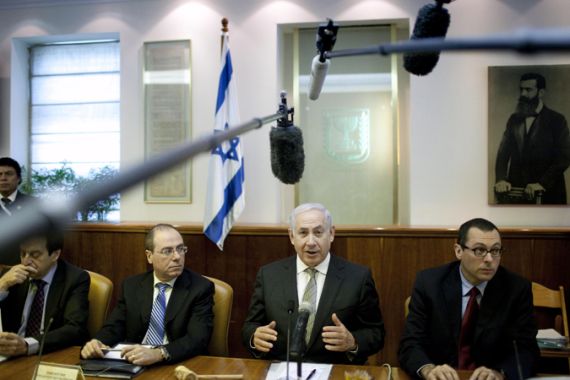Timeline: Politics in the state of Israel
Coalition governments often fall before their term expires and political alliances can shift quickly.

1948: The State of Israel is proclaimed amid civil war in British-administered Palestine. The new state finds itself at war with five Arab countries: Iraq, Jordan, Syria, Lebanon, and Egypt.
1949: Israel is admitted into the United Nations and signs armistice agreements with Egypt, Jordan, Syria, and Lebanon.
1967: Israel fights the Six-Day War with Syria, Egypt, and Jordan.
1973: The Yom Kippur War against Egypt and Syria lasts 19 days, leaving thousands dead and tens of thousands wounded.
1977: The right-wing Likud Party forms a government after elections, ending 30 years of Labour Party rule.
1978: Israel-Egypt peace treaty signed.
1987: Beginning of the first Palestinian intifada, or uprising.
1993: Oslo Accords signed between Israel and the Palestinian Liberation Organisation.
1995: Former director general of the ministry of defence, Shimon Peres, becomes prime minister after Yitzhak Rabin is assassinated.
1999: A centre-left coalition government is formed by Israel’s most decorated soldier, Ehud Barak.
September 2000: Second Palestinian intifada erupts following riots surrounding Ariel Sharon’s visit to Jerusalem’s Temple Mount, also known as al-Haram al-Sharif, site of the Al-Aqsa mosque – one of the three most sacred sites in Islam.
2001: Former major general Ariel Sharon is elected prime minister.
2005: Israel withdraws settlers and military forces from inside the Gaza Strip.
November 2005: Sharon resigns from the Likud Party and forms Kadima.
December 2005: Former Army captain and ambassador Binyamin Netanyahu is elected Likud leader.
January 2006: Sharon suffers a major stroke, and former journalist Ehud Olmert becomes caretaker prime minister.
Jananuary 2006: Hamas wins Palestinian parliamentary elections, angering Israel and the US.
March 28, 2006: Olmert’s Kadima Party wins the most seats in elections.
March 29, 2006: Palestinian President Mahmoud Abbas swears in a Hamas-led government.
April 9, 2006: Israel formally severs all direct contact with the Hamas-led Palestinian government, leading international isolation of Hamas, particularly in the Gaza Strip.
July-August 2006: A war between Israel and Hezbollah causes huge damage and the deaths of at least 1,100 people in southern Lebanon and 165 Israelis.
July 2008: Facing a corruption probe and accusations that he mishandled the war, Olmert announces plans to step down.
September 2008: Tzipi Livni is elected to lead Kadima.
December 2008: Operation Cast Lead is launched in Gaza. As many as 1,400 Palestinians and 13 Israelis are killed during 22 days of bombardment.
Feb 2009: Binyamin Netanyahu is elected prime minister.
March 2010: Israeli commandos kill nine Turkish activists aboard an aid flotilla bound for Gaza.
2011: Israeli analysts frequently express concern about the Arab Spring uprisings in the region.
November 2012: Israel attacks the Gaza Strip in Operation Pillar of Defence. Around 150 Palestinians and six Israelis are killed during a week of attacks and counter-attacks.
January 22, 2013: Elections for the 19th Knesset, or parliament, to be held.